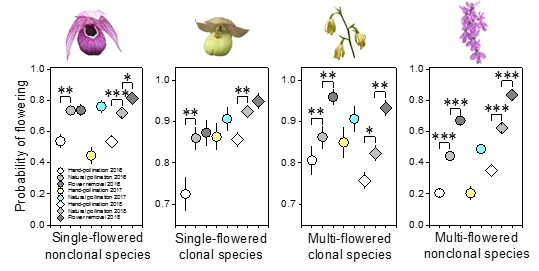Researchers from the Institute of Botany of Chinese Academy of Sciences found that trade-off between current reproduction and future performance is associated with flowering strategy and clonality, by using a multi-species experimental approach.
This study entitled “The expression of demographic costs of reproduction varies among coexisting plants with different life history traits” was recently published in Journal of Ecology.
The researchers used an ideal system, including four species of coexisting nectarless orchids, where two species are nonclonal (Cypripedium tibeticum and Ponerorchis chusua), two are clonal (C. flavum and Phaius delavayi), and each growth form includes a single- and a multi-flowered species.
By experimentally increasing and reducing reproductive effort over three years, the researchers observed that comparing to reduction in reproduction by flower removal, natural reproduction significantly reduced growth and fecundity, whereas increase in fruit production by hand-pollination additionally reduced sprouting probability.
They further found that demographic costs were clearly stronger in multi-flowered species compared to single-flowered ones, but the pattern was less clear regarding clonality. Contrary to predictions, costs were independent of clone size in clonal species.
Higher biomass allocation to reproductive parts and a longer flowering period may explain high costs of reproduction observed in multi-flowered species.
“Trade-off is an important issue in evolutionary biology and many studies have investigated spatial and temporal environmental effects on it. But this study is one of a few to detect trait-dependent life history trade-offs, and thus provides new data for understanding life history evolution,” said Dr. SUN Haiqin, the correspondence author.

The effect of reduced (flower removal) and increased (hand-pollination) reproductive effort on flowering performance of four coexisting species in three consecutive years.
Article Link: https://doi.org/10.1111/1365-2745.13951
Contact:
SUN Haiqin
Institute of Botany, the Chinese Academy of Sciences
Email: hqsun@ibcas.ac.cn
Researchers from the Institute of Botany of Chinese Academy of Sciences found that trade-off between current reproduction and future performance is associated with flowering strategy and clonality, by using a multi-species experimental approach.
This study entitled “The expression of demographic costs of reproduction varies among coexisting plants with different life history traits” was recently published in Journal of Ecology.
The researchers used an ideal system, including four species of coexisting nectarless orchids, where two species are nonclonal (Cypripedium tibeticum and Ponerorchis chusua), two are clonal (C. flavum and Phaius delavayi), and each growth form includes a single- and a multi-flowered species.
By experimentally increasing and reducing reproductive effort over three years, the researchers observed that comparing to reduction in reproduction by flower removal, natural reproduction significantly reduced growth and fecundity, whereas increase in fruit production by hand-pollination additionally reduced sprouting probability.
They further found that demographic costs were clearly stronger in multi-flowered species compared to single-flowered ones, but the pattern was less clear regarding clonality. Contrary to predictions, costs were independent of clone size in clonal species.
Higher biomass allocation to reproductive parts and a longer flowering period may explain high costs of reproduction observed in multi-flowered species.
“Trade-off is an important issue in evolutionary biology and many studies have investigated spatial and temporal environmental effects on it. But this study is one of a few to detect trait-dependent life history trade-offs, and thus provides new data for understanding life history evolution,” said Dr. SUN Haiqin, the correspondence author.

The effect of reduced (flower removal) and increased (hand-pollination) reproductive effort on flowering performance of four coexisting species in three consecutive years.
Article Link: https://doi.org/10.1111/1365-2745.13951
Contact:
SUN Haiqin
Institute of Botany, the Chinese Academy of Sciences
Email: hqsun@ibcas.ac.cn
